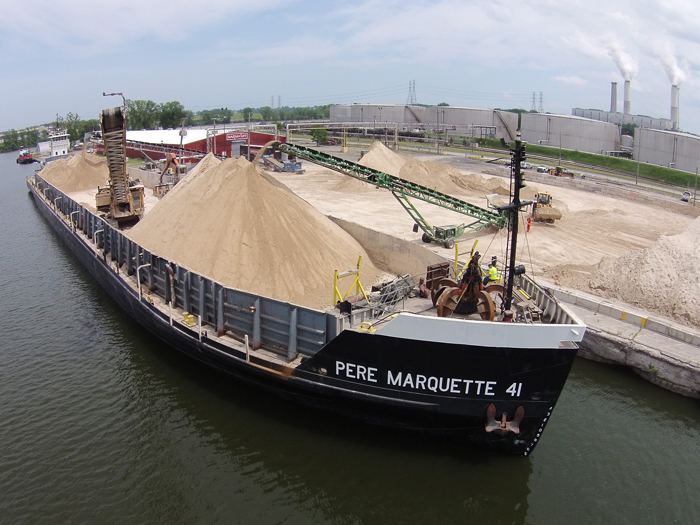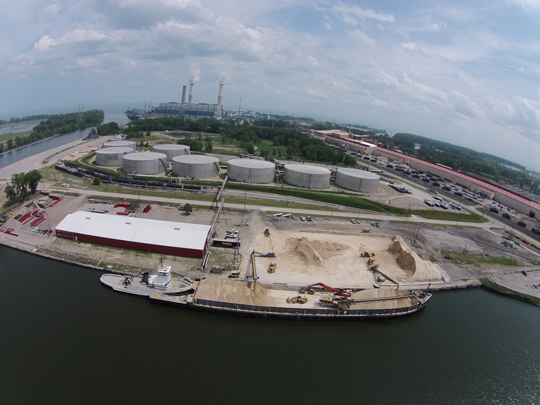
As published in Toledo Business Journal - January 1, 2016

The barge Pere Marquette 41 has been a frequent visitor to the Port of Monroe
loading synthetic gypsum for export to Canada
The Port of Monroe, Michigan has entered into a new agreement with DTE Energy for the transport of synthetic gypsum, produced near the port, which will require several upgrades and an expansion of the dockage area.
“This is the first agreement of its kind between a public port and a public utility for the complete management of a product at a power generation facility,” said Port director Paul LaMarre. “The reason this has such value to both parties is that it ensures that we keep a product that is produced in the Port of Monroe also moving across the port’s docks.
“The gypsum is produced at Monroe Power Plant, which is located within the Port of Monroe industrial park,” he continued. “They are our largest tenant as well as the largest employer and tax revenue generator in Monroe County. The synthetic gypsum operation is a win-win in that the production of the material is produced by making the emissions from the power plant cleaner. It is cargo inbound from Rogers City, Michigan as limestone, and cargo outbound as synthetic gypsum once it’s gone through the scrubbing process.”
According to LaMarre, the port recently received a $3.7 million grant from the State of Michigan through the Michigan Economic Development Corporation (MEDC) and Michigan Department of Environmental Quality (DEQ). This will enable them to build a new riverfront dock facility that will allow for the simultaneous loading and unloading of multiple vessels and allow the further diversification of the cargoes that move through the port, one of which will be the synthetic gypsum.
“The first ever grant by a State to a public dock was awarded to the Port of Monroe this year for around $3 million to expand our dockage area,” said Anthony Gray, owner of DRM Maintenance & Management, which manages the Port of Monroe. “Paul Lamarre had a great hand in working on that project to eventually get that approved, so that was quite an undertaking and a two to three year process that was just approved this year. They should be done by late summer next year.”

Aerial view of the Port of Monroe
According to Gray, in addition to the dockage expansion DRM has also purchased larger conveyers, loaders, and trucks to deliver the gypsum to customers. The company is also planning a $600,000, 24,000 square foot building to help house and transition the gypsum from the power plant over to the port. Winkler Construction, LLC, in Belmont, Michigan, will be the general contractor for this project, expected to be finished in April.
“We work side by side with the Port director at looking at other bulk cargoes and project cargo,” said Gray. “We tend to try to deal with logistics that are important to our port and our area, and what I mean by that is gypsum that is made is 800 feet away from our port, so we obviously have a very strong logistical marketing ability for that product. So we don’t run up to Detroit, or Port Huron, or down to Toledo looking for business, we let business come to us that says the Port of Monroe makes more sense, or this is something they haven’t done before and want to see if it works, and then we work on the logistics to see if it does. We’re challenged by the depth of our water there, we don’t have 25 or 26 feet, we’re 21 to 23 feet, so that’s a challenge for the port. It will never compete with Toledo or Detroit for many, many cargoes, but for certain domestic logistical cargos and project cargoes it’s coming in safe for the Monroe County and that area, and sometimes it makes sense that we can do that.”
Gypsum is produced as a byproduct in the flue gas desulfurization system of the Monroe power plant, which removed 90% of the plant’s sulfer dioxide emissions. According to LaMarre, the two primary uses of gypsum are for wallboard and as a soil enhancer for the fertilizer industry. According to Gray, gypsum is also used by cement manufacturers.
“It goes into gypsum wallboard. It goes into cement, like for LaFarge, and St. Mary’s Cement uses the product,” said Gray. “It’s been used for many years in other states, like Ohio, Indiana, and Wisconsin, but last year they approved the gypsum to be used in Michigan also for the agriculture market. So there’s domestic market for that and the agriculture business is also an international market for that product. It can be used as bulk and spread by farmers, or it can be pelletized, which makes it a more blendable product. We’re talking with companies that possibly could come to the City of Monroe and possibly could do some blending of the product as well.”
“There’s a number of uses, he added. “The Port of Monroe, about two years ago, paid for a study to analyze the overall usage and markets for gypsum, which I think was instrumental in showing that they would be a good partner with DTE.”
DRM hopes to hire at least another 20 people at the port over the next 18 months, according to Gray. The 38-year old company has put about 18-20 people to work and invested about $2 million since they began managing the port three years ago.
“We have a long-term agreement with the port to be the terminal managers, and there are specific requirements within the agreement,” said Gray. “We also have an agreement with the port that includes managing and selling and assisting the port with the distribution, storage, and shipping of synthetic gypsum and other bulk products from them.”
“The port of Monroe sat idle for almost 50 years,” he added. “It never got busy until they hired the new port director, Paul LaMarre. He is a very aggressive, knowledgeable, visionary young man, and he saw an opportunity for the port to grow if worked properly with the right team. He has a very good board of directors who work with him very closely, so he brought me on board for the public / private partnership so the port could move forward quicker.”
“I became port director during the summer of 2012,” said LaMarre. “Prior to that the port had not had a director in over 30 years. Being third generation in the Great Lakes maritime industry, and previously having been the manager of Maritime Affairs for the Toledo-Lucas County Port Authority, I saw the Port of Monroe as a storied port facility in need of restoration. We have all the major transportation assets needed to supply efficient and economic cargo handling services to the region and beyond. The port serves as the glue that binds all of our tenants and transportation partners together to operate a single functioning unit.
“The last two seasons at the port have seen the most exponential tonnage gains of any other port on the Great Lakes,” he continued. “In hopes of continued growth, my goals are continued cargo diversification, job creation, subsequent tax revenue generation, and ultimately a better quality of life for the citizens of Monroe. And… those goals contribute to my lifelong goal and passion of sustaining the Great Lakes maritime industry past, present, and future.”